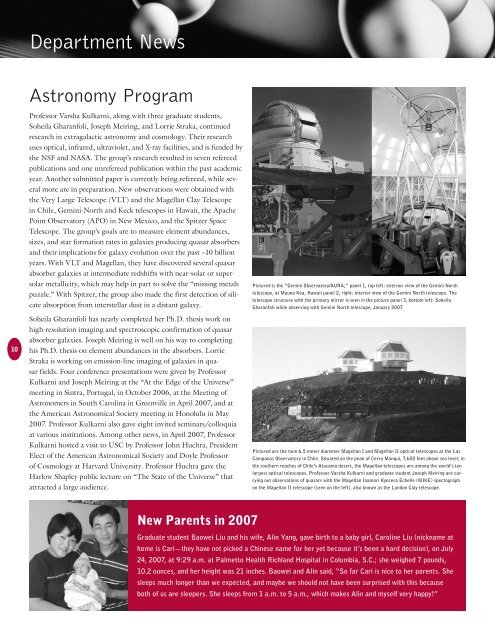2007 - Physics and Astronomy - University of South Carolina
2007 - Physics and Astronomy - University of South Carolina
2007 - Physics and Astronomy - University of South Carolina
Create successful ePaper yourself
Turn your PDF publications into a flip-book with our unique Google optimized e-Paper software.
Department News<br />
<strong>Astronomy</strong> Program<br />
10<br />
Pr<strong>of</strong>essor Varsha Kulkarni, along with three graduate students,<br />
Soheila Gharanfoli, Joseph Meiring, <strong>and</strong> Lorrie Straka, continued<br />
research in extragalactic astronomy <strong>and</strong> cosmology. Their research<br />
uses optical, infrared, ultraviolet, <strong>and</strong> X-ray facilities, <strong>and</strong> is funded by<br />
the NSF <strong>and</strong> NASA. The group’s research resulted in seven refereed<br />
publications <strong>and</strong> one unrefereed publication within the past academic<br />
year. Another submitted paper is currently being refereed, while several<br />
more are in preparation. New observations were obtained with<br />
the Very Large Telescope (VLT) <strong>and</strong> the Magellan Clay Telescope<br />
in Chile, Gemini-North <strong>and</strong> Keck telescopes in Hawaii, the Apache<br />
Point Observatory (APO) in New Mexico, <strong>and</strong> the Spitzer Space<br />
Telescope. The group’s goals are to measure element abundances,<br />
sizes, <strong>and</strong> star formation rates in galaxies producing quasar absorbers<br />
<strong>and</strong> their implications for galaxy evolution over the past ~10 billion<br />
years. With VLT <strong>and</strong> Magellan, they have discovered several quasar<br />
absorber galaxies at intermediate redshifts with near-solar or supersolar<br />
metallicity, which may help in part to solve the “missing metals<br />
puzzle.” With Spitzer, the group also made the first detection <strong>of</strong> silicate<br />
absorption from interstellar dust in a distant galaxy.<br />
Soheila Gharanfoli has nearly completed her Ph.D. thesis work on<br />
high-resolution imaging <strong>and</strong> spectroscopic confirmation <strong>of</strong> quasar<br />
absorber galaxies. Joseph Meiring is well on his way to completing<br />
his Ph.D. thesis on element abundances in the absorbers. Lorrie<br />
Straka is working on emission-line imaging <strong>of</strong> galaxies in quasar<br />
fields. Four conference presentations were given by Pr<strong>of</strong>essor<br />
Kulkarni <strong>and</strong> Joseph Meiring at the “At the Edge <strong>of</strong> the Universe”<br />
meeting in Sintra, Portugal, in October 2006, at the Meeting <strong>of</strong><br />
Astronomers in <strong>South</strong> <strong>Carolina</strong> in Greenville in April <strong>2007</strong>, <strong>and</strong> at<br />
the American Astronomical Society meeting in Honolulu in May<br />
<strong>2007</strong>. Pr<strong>of</strong>essor Kulkarni also gave eight invited seminars/colloquia<br />
at various institutions. Among other news, in April <strong>2007</strong>, Pr<strong>of</strong>essor<br />
Kulkarni hosted a visit to USC by Pr<strong>of</strong>essor John Huchra, President<br />
Elect <strong>of</strong> the American Astronomical Society <strong>and</strong> Doyle Pr<strong>of</strong>essor<br />
<strong>of</strong> Cosmology at Harvard <strong>University</strong>. Pr<strong>of</strong>essor Huchra gave the<br />
Harlow Shapley public lecture on “The State <strong>of</strong> the Universe” that<br />
attracted a large audience.<br />
Pictured is the “Gemini Observatory/AURA;” panel 1, top left: exterior view <strong>of</strong> the Gemini North<br />
telescope, at Mauna Kea, Hawaii panel 2, right: interior view <strong>of</strong> the Gemini North telescope. The<br />
telescope structure with the primary mirror is seen in the picture panel 3, bottom left: Soheila<br />
Gharanfoli while observing with Gemini North telescope, January <strong>2007</strong>.<br />
Pictured are the twin 6.5 meter diameter Magellan I <strong>and</strong> Magellan II optical telescopes at the Las<br />
Campanas Observatory in Chile. Situated on the peak <strong>of</strong> Cerro Manqui, 7,600 feet above sea level, in<br />
the southern reaches <strong>of</strong> Chile’s Atacama desert, the Magellan telescopes are among the world’s ten<br />
largest optical telescopes. Pr<strong>of</strong>essor Varsha Kulkarni <strong>and</strong> graduate student Joseph Meiring are carrying<br />
out observations <strong>of</strong> quasars with the Magellan Inamori Kyocera Echelle (MIKE) spectograph<br />
on the Magellan II telescope (seen on the left), also known as the L<strong>and</strong>on Clay telescope.<br />
New Parents in <strong>2007</strong><br />
Graduate student Baowei Liu <strong>and</strong> his wife, Alin Yang, gave birth to a baby girl, Caroline Liu (nickname at<br />
home is Cari—they have not picked a Chinese name for her yet because it’s been a hard decision), on July<br />
24, <strong>2007</strong>, at 9:29 a.m. at Palmetto Health Richl<strong>and</strong> Hospital in Columbia, S.C.; she weighed 7 pounds,<br />
10.2 ounces, <strong>and</strong> her height was 21 inches. Baowei <strong>and</strong> Alin said, “So far Cari is nice to her parents. She<br />
sleeps much longer than we expected, <strong>and</strong> maybe we should not have been surprised with this because<br />
both <strong>of</strong> us are sleepers. She sleeps from 1 a.m. to 5 a.m., which makes Alin <strong>and</strong> myself very happy!”
















